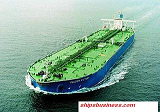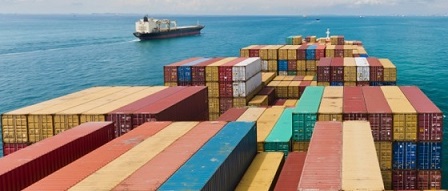A ship's safe maneuverability depends on the available water depth of the navigation area concerning the vessel's draft. Water-depth limitations will considerably change the pressure distribution around a moving ship. They will mostly cause an increase of the hydrodynamic forces due to the ship's motion through the water.
Besides the expansion of the ship's resistance, water-depth restrictions generally decrease her maneuverability. The dependency of the maneuverability in the lower Under Keel Clearance(UKC) range is very significant: a small reduction in UKC results in a considerable increase in the turning circle dimensions. As a result, larger bend radii are required in shallow navigation channels.
A ship's directional stability and maneuverability change considerably as a function of the available UKC. Especially in natural waterways (rivers, estuaries) where the water extent may vary significantly, both over the channel and over the tidal cycle, a ship's maneuvering characteristics may be subjected to essential changes transit through the canal.
To ensure safe navigation while approaching shallow water, it is the Master's responsibility, who must calculate precisely under keel clearance requirement for the vessel and ensure that remains afloat at all times.
Recommended safe Under Keel Clearance (UKC) are as follows:
- Open Sea (FAOP): The minimum UKC in the dynamic condition is 50% of the static draft.
- Restricted Waters/Port Approaches/Harbour Transits (SBE): The minimum UKC in the dynamic condition is 10% of the static draft.
- Tankers Only – SBM / CBM mooring: the minimum UKC is 50% of the static draft.
- Alongside (1st Line Ashore to SBE):
For vessels <20m breadth: 0.30 metres &
For vessels >20m breath: 1.5% of the ship’s beam
The Static Draft is the draft when the vessel is not making way or subject to sea, and swell influences, i.e., the maximum draft the ship has loaded to. (UKC is a percentage of the Static Draft)
The Dynamic Draft is the draft when the vessel is making way and subject to squat, sea and swell state and increase of draft due to heel when turning.
Example: Whilst making a port approach, a vessel has a maximum static draft of 11.0m. Squat at the maximum anticipated transit speed of 10 knots is calculated as 0.8m. There is no sea, swell, or appreciable list, so the dynamic draught is 11.8m. The minimum UKC as per this policy is 1.1m, so the vessel requires a minimum depth (Chart Datum + tide) of 11.8 + 1.1 = 12.9m.
Calculating UKC
The following specific factors must be taken into account during voyage planning and recorded prior to proceeding en route:
- Draft observations/calculations including estimates of hogging and sagging;
- Increase in draft due to heaving, pitching and rolling motions;
- The effects of squat
- Increase in draught due to change of water density;
- Minimum charted depth available;
- The predicted height of tide (minimum available during planned transit window);
- State of sea and swell;
Guided by local knowledge and experience, it may be necessary for the Master to factor in an additional safety margin to make an appropriate allowance for the following variables:
- the accuracy of the hydrographic data (references to reliability are often included on charts);
- the vessel’s size and handling characteristics;
- Changes in the predicted tidal height, caused by wind speed and direction and high or low barometric pressure;
- the nature and stability of the seabed – i.e. sand waves, siltation, pipelines, obstructions etc.
Many ocean charts are still mainly based on sparse and inadequate sounding data obtained from a wide variety of sources of varying reliability and accuracy. Chart accuracy is best along well-frequented routes, but even in these waters, undetected dangers may still exist, especially for modern deep-draught vessels. Very little of the Oceans have been thoroughly surveyed. Certain areas are subject to earthquakes and volcanic activity, which could cause shoals to build up even in those areas which have been well surveyed; live coral is continually growing. The approximate positions of many hazardous shallow patches have been charted; these must be given a wide berth.
The Mariner's Handbook, Ocean Passages of the World, and relevant Sailing Directions must be consulted for further information on the dangers of overreliance on charts.
Where a request has been made by charterers to decrease the above parameters, or it is known that the above criteria cannot be met (such as advice from port authorities or Pilot), the Master must notify and seek the ship's approval's DPA. He should indicate the calculated UKC and comparing it to the Company policy. This notification is to be accompanied by a suitable risk assessment carried out on the factors known to the Master. This Risk Assessment should include relevant controls, such as additional bridge manning, minimum speed, tug assistance, soundings & position monitoring. The latest sounding information, including the nature of the bottom, should be ascertained directly from the local authorities or terminal.
Approaches to Shallow Waters
The bridge team must keep the engine room well appraised of the vessel's progress. The cooling water intake must be changed over to the high sea suction before the ship enters an area where the under-keel clearance is restricted. Considerable quantities of mud and debris can be drawn into the cooling system if this is not done in time.
Alongside
A minimum UKC while alongside, following the requirement above, must be noted in the Cargo Handling Plan. It must include instructions outlining the maximum draft, trim, and list.
Taking the Ground
There may be occasions where, through the nature of the port, smaller vessels are required to 'take the ground,' i.e., sit on the bottom. In such circumstances, the ship should be certified by class for ground loading / discharging. Furthermore, a risk assessment must be prepared in advance of the port call to assess the vessel's risks, including: fully.
- The effects of stress and stability;
- The nature and level of the bottom;
-
Vessel requirements for maintaining services such as fire-fighting and engine cooling water.
Based on this risk assessment, Critical Operations Checklists should be developed for taking the ground and subsequent re-floating, and these should be referenced in the cargo plan.
Squat and Interaction
The squat is the bodily sinkage of a ship in the water when making headway. It varies from ship to ship. The amount of squat will depend upon several factors but in certain conditions may be as much as two meters. If not factored appropriately, this could lead to grounding, loss of steering, and/or collision.
When navigating in channels or areas with restricted depth, increased draught due to squat must be taken into account. It must be borne in mind that this effect will increase with speed and is greater when the channel is also restricted in breadth. The handling characteristics of the vessel may appreciably deteriorate when navigating in shallow water, in narrow channels or when navigating close to other vessels.
The squat can occur with a moored vessel, in an ebb tide, alongside a jetty. Tide speed along the stationary vessel produces components of bodily sinkage and trimming effects. The two combined give ship squat for a stationary ship. It should be considered when calculating UKC alongside. Particular allowance should be given to the impact of sea and swell when the vessel is engaged in operations at an offshore mooring such as an SBM.
The UKC calculation record must be shown to the Pilot during the Master-Pilot information exchange discussion.
See Attached Documents for factors governing ship squat and how to calculate squat.
Squat information relevant to the vessel for both loaded and ballast passages should be displayed on the wheelhouse poster compliant with IMO Res. A.601(15) and included on the Ship to Shore Master/Pilot Information Exchange provided to the Pilot.
Confined / Shallow Waters
It must be remembered that the vessel's handling characteristics will be changed when navigating in shallow water or narrow channels and on the close approach of or to other ships.
The effect of shallow water on a ship is:
- More ship's power is absorbed by the water due to increased friction.
- Usually sinkage is greater forward than aft for ships of tanker speed and displacement in any depth.
- Turbulence interferes with rudder and propeller effectiveness.
Signs that the ship has entered shallow water conditions can be:
- Wave making increases at the ford end of the ship.
- Ship becomes more sluggish to manoeuvre.
- RPM indication will show a decrease. If the ship is in "open water" conditions, i.e., without breadth restrictions, this decrease maybe 15% of the service rpm. If the ship is in a confined channel, this decrease in rpm can be about 20% of the service rpm.
- There will be a drop in speed, If the ship is in "open water" conditions, it may amount to a drop of 60% of the service speed.
- The ship may start to vibrate suddenly because of the entrained water effect causing the natural hull frequency to become resonant with another frequency.
- Pitching reduces, due to cushioning effect of water under the keel
Related Information
Collecting Information and Data for Passage Planning
Ships trial- turning circle diameters
Definitions of various tide terms and related guideline
Ships navigation -Factors Affecting Turning circle diameter
More info pages
- Ships motion at sea and required precautions
Ships are affected by movement in six degrees of freedom; rolling, pitching, heaving, swaying, surging and yawing. Of these, rolling, pitching and heaving generate the highest forces during heavy weather. Read more.....
- Stress and Stability Calculation ,draft , trim & free surface effect
The Master shall ensure that the conditions of stability, hull strength, draft and trim of the vessel at sea and on arrival / departure at / from port and during loading / unloading cargo, bunkering and water ballast exchange, have been worked out, to secure safety of the vessel. He shall confirm the safety of the vessel by proper GM, stress and other factors as being within appropriate Limits.Read more.....
- Passage planning requirement for safe navigation at sea
Before proceeding to sea, the Master shall carefully check the Passage Plan, made after receiving the voyage instruction from the Charterer or the Company. Read more.....
- Safe anchoring practice
Anchoring into "Deep water" which is defined depth of water is beyond 50 meter, must be carried out with "Walk-back Style, however, on the VLCC operation there exists such a big inertia, Master can treat with Walking-back style even in the anchorage where water depth less than 50m, if following conditions are to be forecasted.
Read more.....

For any comments or suggestions please Contact us
Site Use and Privacy - Read our privacy policy and site use information.
Terms and conditions of use
Copyright © 2010 www.shipsbusiness.com All rights reserved.

|
Ships business.com

Shipsbusiness.com is merely an informational site about various aspects of ships operation,maintenance procedure, prevention of pollution and many safety guideline. The procedures explained here are only indicative, not exhaustive in nature and one must always be guided by practices of good seamanship. User feedback is important to update our database.For any comments or suggestions please Contact us

Other info pages !
Tanker vessel safety guideline Check items in oil tankers operation
Questions from user and feedback Read our knowledgebase
Cargo care at sea Precautions to be taken
Reefer cargo handling Troubleshoot and countermeasures
DG cargo handling Procedures & Guidelines
Cargo securing Check items prior departure port
Safe navigation Various factors affecting ships navigation at sea
Hull strength & stability Prior loading how to ensure hull strength & stability of ship
stevedores injury How to prevent injury onboard
Environmental issues How to prevent marine pollution
Safety in engine room Standard procedures
Site Map Page listing for this site.
Home page

|
|




![]()
![]()